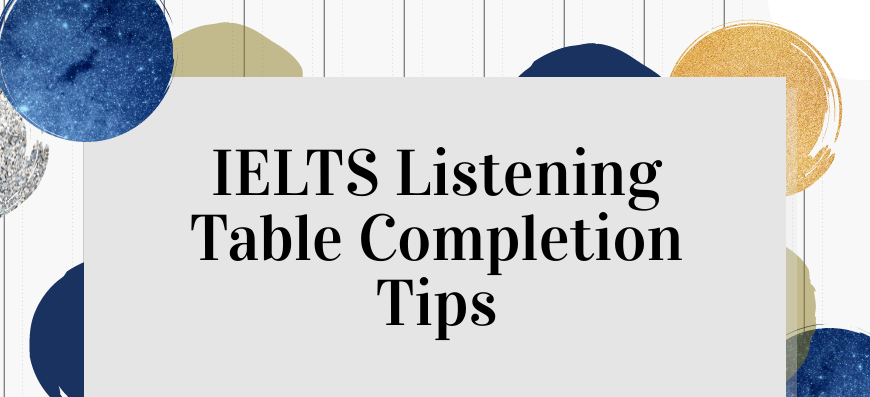IELTS Listening Table Completion Tips

A common question type that is part of the most IELTS Listening tests is the table completion question. Handling such question types requires a dedicated approach that can be practiced and then perfected using adequate sample tests. Here are some tips that can help you to handle table completion question types with ease.
Underline Keywords to know exactly what to hear
Underlining keywords are a great tool that can help you to crack the table completion question types by breaking it down into smaller steps. With the underlining of keywords, you can listen to the audio more attentively whenever such keywords appear. This would more or less shortlist and will pinpoint you to the exact answer for table completion.
Listen Attentively
The key to ensuring you crack the table completion question type is in listening to the audio with apt attention. Knowing what information to look for gives you a massive head start once the audio starts playing out. Keep a note of voice undertones and emphasis on words and names which are often part of the table completion sequence.
Write the word as you hear it
Once the audio starts playing out, keep writing the words that you believe are the right answers as you hear them. Table completion would require you to list the exact word as you hear in the audio. This is all the more reason to listen to the audio with proper attention.
Don't ignore measurement word or abbreviation
Table completion comes with its unique set of challenges and one such challenge is to focus on short forms or abbreviations. Sometimes in a table completion sequence, you may have to write a numbered followed by a measurement word or abbreviation like m, cm, hours, etc. Unless you are attentive to the details, it is very likely that the abbreviation can be overlooked or missed entirely. Reading the question attentively and listening to the audio aptly will make sure you do not skip out on such essentials. If you are still feeling under-prepared for writing abbreviations, opt for some of the practice tests listed here. These tests come with table completion question types including ones with measurement words and abbreviations that can help you to feel confident to tackle such questions.
Keep an eye out on the word limit
A table completion like other questions requires apt attention on the maximum word limit. As elementary as it may sound writing one word for a 2-word question or vice versa is a common mistake in table completion. The key is to read the question carefully before the audio starts playing to ensure you to know exactly the number of words you may be looking for to fit in the table completion sequence.
Keep Practicing
Practicing makes a man perfect and tackling IELTS listening table completion question types is no different. Opt for sample tests listed here to practice the above-mentioned tips thoroughly before to attempt the question on the final exam day.
Underline Keywords to know exactly what to hear
Underlining keywords are a great tool that can help you to crack the table completion question types by breaking it down into smaller steps. With the underlining of keywords, you can listen to the audio more attentively whenever such keywords appear. This would more or less shortlist and will pinpoint you to the exact answer for table completion.
Listen Attentively
The key to ensuring you crack the table completion question type is in listening to the audio with apt attention. Knowing what information to look for gives you a massive head start once the audio starts playing out. Keep a note of voice undertones and emphasis on words and names which are often part of the table completion sequence.
Write the word as you hear it
Once the audio starts playing out, keep writing the words that you believe are the right answers as you hear them. Table completion would require you to list the exact word as you hear in the audio. This is all the more reason to listen to the audio with proper attention.
Don't ignore measurement word or abbreviation
Table completion comes with its unique set of challenges and one such challenge is to focus on short forms or abbreviations. Sometimes in a table completion sequence, you may have to write a numbered followed by a measurement word or abbreviation like m, cm, hours, etc. Unless you are attentive to the details, it is very likely that the abbreviation can be overlooked or missed entirely. Reading the question attentively and listening to the audio aptly will make sure you do not skip out on such essentials. If you are still feeling under-prepared for writing abbreviations, opt for some of the practice tests listed here. These tests come with table completion question types including ones with measurement words and abbreviations that can help you to feel confident to tackle such questions.
Keep an eye out on the word limit
A table completion like other questions requires apt attention on the maximum word limit. As elementary as it may sound writing one word for a 2-word question or vice versa is a common mistake in table completion. The key is to read the question carefully before the audio starts playing to ensure you to know exactly the number of words you may be looking for to fit in the table completion sequence.
Keep Practicing
Practicing makes a man perfect and tackling IELTS listening table completion question types is no different. Opt for sample tests listed here to practice the above-mentioned tips thoroughly before to attempt the question on the final exam day.
Posted
September 04, 2019





